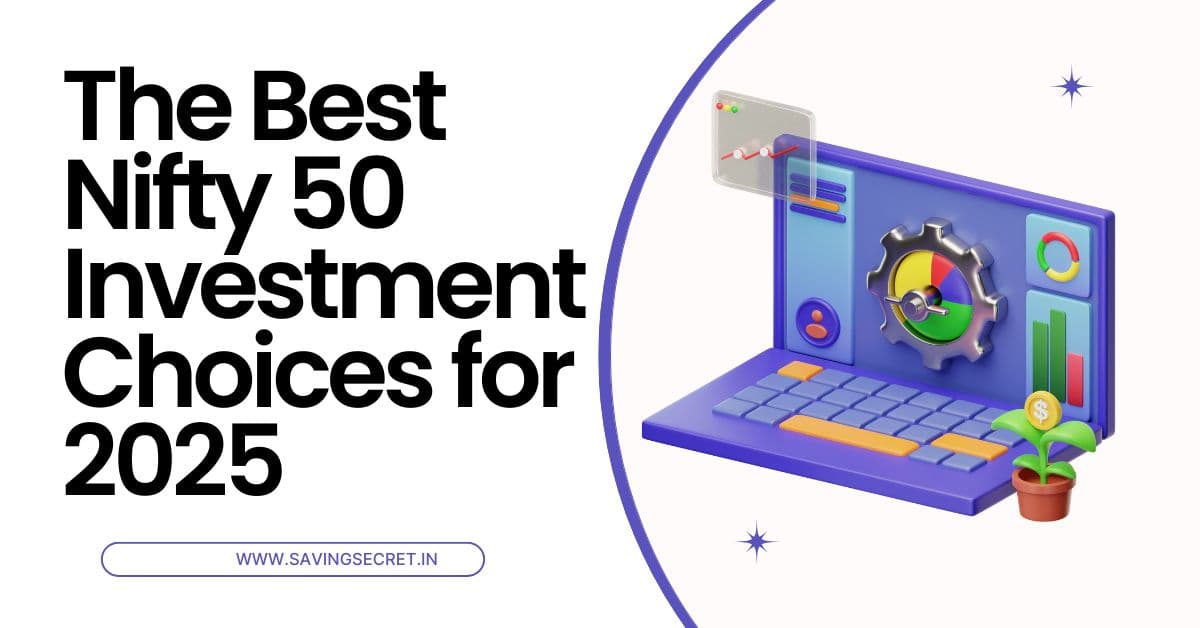Nifty 50 Investment Guide: Investing in the Nifty 50, the main stock market index of the National Stock Exchange (NSE), is a potent means to increase wealth in India, where millions of people aspire to financial independence. The Nifty 50, which represents the top 50 businesses in 14 industries, ranging from HDFC Bank to Reliance Industries, has produced average annual returns of 12–15% over the last ten years (as of 2025 NSE data). Whether you’re a senior in Chennai looking for growth, a paid professional in Bangalore investing ₹10,000, or a student in Mumbai saving ₹1,000 per month, it’s an easy and affordable way to get started in the stock market.
We’ll describe the Nifty 50, why it’s a good option for novice investors, how to start with as little as ₹500, and the best ways to increase your investment. Online investment has never been easier, especially with inflation at 5-6% and India’s digital economy increasing (UPI transactions reached 14.4 billion in February 2025). Let’s get started on your Nifty 50 investing adventure right now!
Why the Nifty 50 is ideal for beginners in India
60% of the NSE’s market capitalisation (₹400 lakh crore in 2025) comes from the top 50 blue-chip Indian firms, including Infosys, TCS, and SBI, which are tracked by the Nifty 50. It should go without saying for novices because:

- Diversification: distributes risk across industries and includes banking, IT, FMCG, and energy.
- Strong Returns: ₹10,000 increases to ₹1.5 lakh in ten years at a 12–15% CAGR (2000–2025).
- Low Cost: Index funds and ETFs have costs of 0.1% to 0.5%, whereas active funds have fees of 1% to 2%.
- Simplicity: Invest in India’s growth with a single fund rather than choosing stocks.
- Accessibility: Use Groww, Zerodha, or SBI SIPs to start with ₹500.
The Nifty 50 is a reliable option for building wealth, with 50 million SIP accounts and an AUM of 60 lakh crore in mutual funds in India (2025 AMFI statistics). Let’s examine investing for beginners.
Nifty 50 Investing Guide: A Comprehensive Road Map
This comprehensive tutorial, designed for Indian novices, offers 12 doable stages, investment possibilities, examples, and advice on how to begin investing in the Nifty 50.

Step 1: Learn About the Nifty 50
- What It Is: India’s economic strength is reflected in an index of 50 large-cap firms, including Infosys (7%), HDFC Bank (8%), and Reliance (10%).
- How it works: Because it tracks stock values, your investment will increase by 10% if the Nifty 50 climbs by 10% (22,000 to 24,200).
- Why for Beginners: Stable—leading companies seldom fail; returns of 12% outperform FDs of 6%.
- For instance, at 22,000, Anil puts ₹10,000 in a Nifty 50 fund; at 24,200, it is worth ₹11.
- By April 25, 2025, take action by reading the NSE’s Nifty 50 FAQ.
Step 2: Understand Why the Nifty 50 Is Better Than Other Choices
Compare:
- In five years, FDs: 5-7%—₹10,000 = ₹17,000, taxable.
- Gold: fluctuating, 6-8%—₹10,000 equals ₹18,000.
- Nifty 50: market-linked, 12%—₹10,000 equals ₹31,000.
- Risky stocks: 15-20%; a ₹10,000 investment might collapse to a ₹5,000 one.
For beginners, the down payment for a property is ₹5,000 per month at 12%, or ₹14 lakh in ten years.
For instance, Priya’s ₹10,000 Nifty fund increased to ₹31,000 in five years, whereas her FD only rose to ₹17,000.
Action: By April 25, 2025, list the advantages of the Nifty.
Step 3: Select Your Investment Type
Choices:
Index funds for the Nifty 50:
- mutual funds (like the UTI Nifty 50 Index Fund) that follow the Nifty 50.
- Fees: 0.1-0.3% (100 naira each year on a 1 lakh rupee).
- 500 SIP is the minimum.
- Why: Affordable and user-friendly for novices.
ETFs for the Nifty 50:
- exchange-traded funds, such as the Nifty 50 Nippon India ETF.
- Fees: 0.05 to 0.2 percent (₹50 annually on ₹1 lakh).
- ₹1,000 is the minimum (demat required).
- Why: Less expensive and trades like stocks.
Avoid Nifty 50 Futures/Options if you’re a beginner
- High risk—10,000 naira might go in a day.
Example: Sunita’s ₹5,000 SIP in the UTI Nifty 50 Fund, for instance, will yield ₹1.5 lakh over seven years.
Action: By April 30, 2025, select an index fund.
Step 4: Verify Eligibility
Who Is Able to Invest?
- HUFs, adults (18+), and kids through legal guardians.
- NRIs and residents—PAN and Aadhaar are required.
Why It Is Important: Everyone is welcome—students may get ₹1,000 SIP, while salaried people can get ₹10,000.
For instance, 20-year-old Anil began a ₹1,000 SIP through his mother.
Action: Verify identification by April 30, 2025.
Step 5: Create an ETF trading and demat account
What to Do: Create a free online account with Groww, Upstox, or Zerodha.
Actions to take:
- Enter your PAN, Aadhaar, and cellphone number in the app.
- Connect your bank account (HDFC, SBI).
- Check the OTP—it will be activated in a day.
The Reason It Works: Purchase index funds for ₹500 or ETFs for ₹1,000; there are no broker fees.
For instance, in only five minutes, Priya opened Zerodha and purchased a ₹5,000 ETF.
Take action: by May 05, 2025, to open an account.
Step 6: Begin with SIPs, or systematic investment plans
- What to do: The best course of action is to invest between ₹500 and ₹5,000 each month in a Nifty 50 index fund, such as the SBI Nifty 50 Index Fund.
- Why It Works: 12% of ₹1,000 per month, or ₹3.3 lakh over ten years, is the average rupee cost.
- Tricks: Raise SIP by 10% every year, or 1,000 to 1,100, or 4 lakh, over a ten-year period.
- For instance, after five years, Anil’s ₹2,000 SIP will equal ₹1 lakh.
- Take action: by May 10, 2025, by initiating a ₹500 SIP.
Step 7: Select the Top Nifty 50 Funds
Leading Funds for 2025
UTI Index Fund for the Nifty 50:
- 0.21% is the expense ratio.
- Returns over 5 years: 12.5%.
- 500 SIP is the minimum.
The ICICI Prudential Index Fund for the Nifty 50:
- 0.17% is the expense ratio.
- Returns: 12.3%.
- ₹100 SIP is the minimum.
Nifty 50 Nippon India ETF:
- Ratio of expenses: 0.05%.
- Returns: 12.7%.
- ₹1,000 is the minimum.
Why It Matters: 1% funds vs. low fees = ₹1,000 saved on ₹1 lakh.
For instance, Sunita’s ₹5,000 UTI SIP will equal ₹1.8 lakh over seven years.
Take action: by May 15, 2025, to select a fund.
Step 8: Make Long-Term Investments
- Steps to take: Hold for 5–10 years. At 12%, ₹5,000 every month becomes ₹14 lakh in 10 years.
- Why It Works: The Nifty 50 rose 10 times between 2000 and 2025, and markets recovered after dipping 10–20%.
- Tricks: SIP averages expenses; ignore dips (22,000 to 20,000).
- For instance, despite a 15% decline, Priya’s ₹10,000 SIP equals ₹3.1 lakh over five years.
- Take action: by May 20, 2025, to commit for five years.
Step 9: Recognise taxes
Guidelines:
- Long-Term Capital Gains (LTCG): 10% on gains over ₹1 lakh (₹2,000 tax on ₹20,000) for periods longer than one year.
- Short-Term Capital Gains (STCG): 15% (₹3,000 on ₹20,000) for less than a year.
Why It Matters: a five-year gain of ₹1 lakh is equal to ₹10,000 in taxes (10% slab).
Hacks: ₹10,000 LTCG vs. ₹15,000 STCG—Hold >1 year.
Anil’s ₹50,000 gain, for instance, equals ₹5,000 in tax (10%).
Take action by May 25, 2025, to plan the holding period.
Step 10: Track and Automate Investing
- What to Do: Use Groww or Zerodha to track and set up UPI auto-pay for SIPs (₹2,000/month).
- Why it Works: Discipline—₹1,000 each month at 12% = ₹6.6 lakh in 15 years is the reason it works.
- Hacks: Apps that track a ₹1 lakh portfolio in five minutes, such as ET Money.
- For instance, in five years, Sunita’s ₹5,000 auto-SIP will become ₹2 lakh.
- Take action: by May 30, 2025, to set up auto-pay.
Step 11: Use the Nifty 50 to diversify
- What to Do: Combine the FDs (₹2,000) and gold (₹1,000) with the Nifty 50 (₹5,000).
- Why It Matters: ₹1 lakh balances risk FD (6%), mitigated by nifty decline (20%).
- Hacks: ₹1.5 lakh in 5 years (₹2,000 Nifty + ₹1,000 SGB).
- For instance, after seven years, Priya’s ₹10,000 mix will equal ₹3 lakh.
- Take action: By June 05, 2025, plan a ₹3,000 mix.
Step 12: Reinvest Returns
- What to Do: Reinvest gains (₹20,000) into Nifty ETFs or SIPs.
- Why It Works: Anil’s ₹10,000 gain to SIPs = ₹50,000 in 5 years; ₹5,000 annually at 12% = ₹2 lakh in 15 years—compounds wealth.
- Take Action: By June 10, 2025, start a ₹500 SIP with winnings.
The Best Nifty 50 Investment Choices for 2025

Are you looking to invest in some of the best-performing large-cap firms in India? ETFs and Nifty 50 index funds provide inexpensive, diversified exposure to the most reliable market performers. With a 0.21% cost ratio, 12.5% 5-year returns, and a ₹500 SIP option, the UTI Nifty 50 Index Fund is a dependable and reasonably priced choice. The ICICI Prudential Nifty 50 Index Fund is perfect for novices, offering a 0.17% expense ratio and ₹100 SIP for even reduced costs. If you enjoy ETFs, the Nippon India ETF Nifty 50 is ideal for active investors since it charges only 0.05%, yields 12.7% 5-year returns, and can be traded like a stock. The SBI Nifty 50 Index Fund, which has a 0.25% cost ratio, a ₹500 SIP, and a 12.2% return, is another wise option. It is supported by a reputable brand. These choices are perfect for passively investing in Nifty 50 equities and accumulating money over the long run.
Nifty 50 Investing Advantages for Beginners
- Growth: ₹14 lakh in ten years, or ₹5,000 per month at 12%.
- Safety: Low failure risk, diversified—50 leading companies.
- Ease: SIPs online—five minutes on Groww—are simple.
- Affordability: Your adventure begins with ₹500.
- Tax Efficiency: 30% FD interest against 10% LTCG.
Examples from Real Life
Anil’s Student Beginning
Anil, a 22-year-old Hyderabadi intern earning ₹10,000 per month:
- Investment: UTI Nifty 50 Fund, ₹1,000 SIP.
- Grew: 12%, or ₹1 lakh, in 5 years.
- “Easy and fulfilling,” he says.
Priya’s Increase in Salary
Mumbai resident Priya, 30, makes ₹50,000 a month:
- ICICI Nifty 50 Fund investment: ₹5,000 SIP.
- grew by 1.8 lakh naira in five years.
- “Greater than my FD,” she says.
Additional Advice for Beginners
- Festive Cash: ₹15,000 over five years—₹5,000 as a Diwali bonus to SIP.
- CIBIL Check: 750+ for loan-free investment; CIBIL Check: Free on Wishfin.
- Digital Ease: 5-minute SIPs, Groww, and Zerodha—free accounts.
- Little Objectives: ₹1.3 lakh for a bike in 5 years (₹1,000 SIP).
- Learn: For Nifty fundamentals, see YouTube (such as Pattu’s Finance).
- Spread your investments: ₹1,000 PPF + ₹2,000 Nifty—balance risk.
- Monitor: ET Money—monitor a monthly portfolio worth ₹1 lakh.
Typical Problems and Their Solutions
- Problem: Fear of the market (20% decline).
Solution: Hold for five years; the Nifty will rebound (10x in twenty-five years). - Problem: The challenge is low returns (20%) compared to equities.
Solution: A 12% loss on the Nifty is safer than a ₹5,000 one. - Problem: No large sum of money.
Solution: The answer is ₹1.3 lakh in five years—₹500 SIP. - Problem: Confusion around taxes is the challenge.
Solution: Use ClearTax as a solution. ₹20,000 gain equals ₹2,000 LTCG. - Problem: Complexity is the challenge.
Solution: Groww’s 5-minute index fund SIP setup.
Why the Nifty 50 Works for Beginners
The ₹400 lakh crore (2025) Indian stock market is a wealth generator:
- Growth: With 50 million investors, the Nifty 50 has increased tenfold since 2000.
- Digital Shift: 70 million people make investing easier with apps and UPI.
- Economic Fit: Wealth is preserved with 5-6% inflation and 12% returns.
Resources and Tools
- Apps: ClearTax (tax), Groww (SIPs), and Zerodha (ETFs).
- Websites: Moneycontrol (advice) and NSE (Nifty data).
- Freebies: include YouTube lessons and SIP calculators (SBI).
- Communities: For help for beginners, see r/IndiaInvestments.
Get Started on Your Nifty 50 Adventure Now!
Get started building wealth right away:
- Create an account on Groww by April 20, 2025.
- By April 30, 2025, begin a ₹500 SIP.
- By May 05, 2026, aim for a portfolio worth ₹1 lakh.
Your path to financial independence begins with the Nifty 50. To encourage wise investment, share this information with your loved ones. Any Indian novice may become an expert Nifty 50 investor by following these methods!
Government Bonds for Beginners: Buy Online Easily
Best SIP Plans for Students to Start Small & Grow Big
How to Invest in Index Funds without Risk: A Beginner’s Guide

